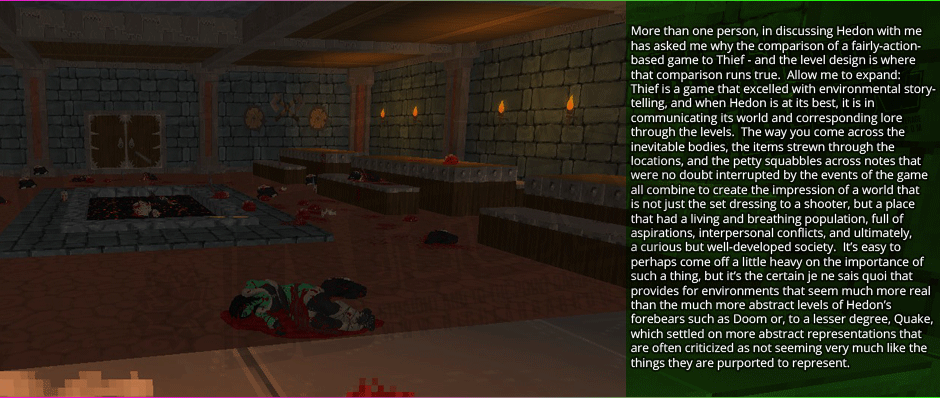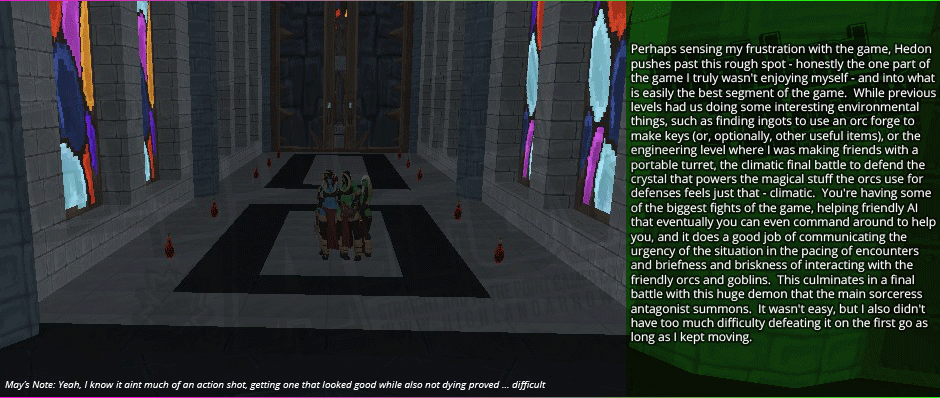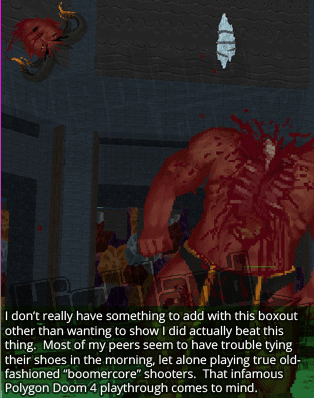

Hedon
Platforms: PC
Reviewed on: PC
Reviewer: Maiyannah Bishop
Review Play-Time: 30h
Developer: Zan
Publisher: Zan
Released: 2019-05-16
Review Published: 2020-05-24
+ Great, atmosphere level design in general
+ Combat is energetic and challenging
+ Compelling world and lore
+ Impressive weapon variety
+ Throwing the axe is amazing fun
- Map could use annotation system
- Particularly-egregious exposition dump segment
- Forced stealth section excruitating
- Music choices seem theme-inappropriate

Editor's Note: This review is of the current, complete version of Hedon available from Steam - however, it should be noted that this version is not actually complete, and comprises one episode of an evidently-planned four. Therefore, it should be considered a review of the first episode thereof.
Hedon is an exploration-based first-person shooter developed and published by Zan. I have to level with you, this game first came to my attention through my now-partner with some degree of scorn over the artwork and the use of the somewhat-controversial GZDoom (well, a fork or derivative thereof). Being the incredulous person I am, who prefers to form her own opinions on games, when I had a little bit of extra pocket money this lovely COVID19 quarantine, I decided to sit down with it and try it out for myself. And I have to say, despite some rough edges, I certainly found it worth my time, and it kept my attention better than most of the retro-revival FPS gaggle that has released in the past few years. It is its own beast however - drawing significantly away from the games that it claims as inspiration, offering a large, segmented world to explore with more focus on environmental storytelling than roleplaying, but ultimately, something with its own unique feel. It's worth a look if something like Ultima Underworld appealed to you, but you want controls that weren't made for frog people from the planet Sprog.
If you thought that preamble was lengthier than my usual, well, you're right, but I wanted to boil it down for people who just want a yes or no, because getting into the details below is going to involve spoilers. So ... don't want it spoiled, but want to know if it's worth picking up? I'd say if something like Ultima Underworld appealed to you, then yes, it assuredly is. If not, then maybe still yes, because the fighting and shooting are still very good, if you can stomach long periods in between it ... but definitely not if you can't.
So without further ado, lets break it down. And in case you didn't read it above: spoilers ahead. Oh, and if you expect me to touch on the GZDoom controversies - well, I probably will at some point, but it's outside of the scope of a game review. We're just going to focus on the technical aspects as regards to the game.
Hedon begins you in the middle of a prison-cell-looking place, evidently fighting through the pixellated and atmospheric halls that are evidently the Hell of the fantasy realm the protagonist inhabits. Quickly dispatching some sort of hellhound beast and finding some of our fellows trapped, we're left with finding a way to help them escape a position they are pinned in. So began the first of what would be many sojourns through the expansive landscapes of Hedon and the truthfulness of claims that I can be aggressively blonde sometimes.
And thence to such explorations I took, exploring through the surrounds of the ruined battlefield to try to riddle out the way to progress. This is where I find my first difficult criticism to make, because it is not the fact that I wasn't led by my hand to the answer which I find a bit odious, but rather, that the signposting is so minimal. We live in a time and culture where people want instant gratification and while I don't count myself among the obsessive "ooh look at what I had for dinner" narcissism of the modern attention-craving culture (with side apologies to Justice ODonnell of the St. Catherine's Court whose footnotes in R v Duncan I am remembering that from), I find that Hedon is the pendulum gone perhaps a bit too far in the opposite direction. I explored for about half an hour, trying to jump over lava pools, finding only a secret, and man, do I just love finding secrets when I'm trying to progress. Wait, did I say love? What I meant is hate. It is easy to confuse the two, sometimes.
Pettiness of checking the teeth of gift horses aside, I nonetheless had difficulty out of the gate in terms of finding the way to go forward. The levels are brilliant - large, and atmospheric, and offering a sense of the world being a place actually lived in by people and having functional layouts that do the Duke Nukem 3D thing of essentially starting largely blocked off, but opening up as they go on. This becomes a mixed blessing, however, since it means that the game has a harder time directing the player as to which areas are new and should be explored. It demands an amount of memory and discipline from the player that I would be lying to say I didn't chafe with. However, I chafed more at the lack of tools. In Ultima Underworld, I didn't mind that so much, because you could make notations on the map to leave yourself notes of an area. You have no such mechanism in Hedon, and relying on my batty, adult-unsafe mind to remember what I ate for lunch sometimes is an onerous request, let alone the various locations in such large and frankly beautiful areas, in their own retro way.
Indeed, let's take a little moment's respite to appreciate the beauty of the artistic level design that was put into these levels. These levels are, in a certain retro way, simply gorgeous. The care with which they are wrought is communicated through the passion with which the lore is crafted through notes, and more notably to my eye, the environmental storytelling. The way a shrine has offerings by it, or one in a contested area was surrounded by corpses of those who ardently defended the place of worship of their presumed god or spirit is but one example of a lot of thought given to the diagetic sense of the world, and it feels much more real than most other retro games, both modern and historic.

It becomes trivially easy to get wrapped up in the world-building of the game, and that's not a bad thing in the least stretch. We're presented with the ruins of what remains of an orc-and-goblin society that found some magic crystals and merged that with technology to make a sort of society around "magitech" as the term often is made, and left to rummage through notes and scenes left behind. Indeed, the game starts us essentially in media res in a cave with little memory of how we got there, once we get past that initial attack, which is presented as a sort of prologue memory. Figuring out who is attacking and what is going on even exactly is left to what we can puzzle out from the environment and our limited interactions with others - usually done from behind barriers and the like. The game generally uses the latter to try to tug you in the right direction, and beyond that first attack sequence I find it was better about signposting for the player if you're attentive - though I would note its bad habit of spawning enemies in behind you did have me circling back when I shouldn't be a few times, and I did sometimes find the hints for progression in notes got lost in the lore. All in all though, once the game found a pace through these frankly gorgeous (in their way) environments, it was a blast, albeit a slower-paced one than I think others might have expected. It takes you through a sojourn through a curiously female-only society of orcs and goblins - not sure if this designed or not, but the only male character in the game is a single dwarf you come across. All the same, I found it captivating enough of an experience to want to press on.

The art design is a central component of much of how much this works for the game, and while it is definitely the chunky pixels of yester-year (well, yester-decade, at this point), it is executed quite well and coherently. The weapon models in particular are done really well and stand out as well-animated for pixel art. This is often something a lot of these games get wrong - when you're in that kind of retro graphics with much fewer pixels to work worth, it becomes especially important to communicate clearly to the player what is going on, when attacks connect and don't, and Hedon executes this very well. The levels are then further elevated with some really expertly-done texture art that pulls it together and pulls it off well, with only some sadly unavoidable issues with trying to aim down or up with floating-point sprites - and some some general faff with the sprites.
Most of my complaints when it comes to the art are more towards nit-picking and pet peeves than fundamental problems with it, but I would be remiss not to mention them. There seems a general problem of scale in the game with many sprites. While I could forgive the overly-large-seeming weapon sprites as a gameplay mechanical convenience so they stand out, and statues that seemed to dwarf my character as merely being huge statues in what seemed to be places of worship where such a thing made sense, most but not all of the enemies seemed overly large, while the bodies seemed in comparison relatively small. This is likely a matter of sprite scaling in the engine, but it did stand out for me considerably in some parts. A lot of the character sprites seemed to have really bad cases of small hand syndrome too, and while once being an artist before my right hand got messed up and able to sympathise, it nonetheless distracts and detracts from what is otherwise really brilliant art design. Also, a small bit of lack of attention to detail: the player model is shown with a gun that doesn't quite match any of the weapons, but I think is supposed to be the crossbow? Hey, in my defence, I did say we were in pet peeve territory here.
Said pet peeves aside, the environments in particular are well done. There's consistency where things should be consistent, and variation in places that would indeed be different, with for instance the Dwarf keep type place having a very different visual look than the orc and goblin type places, as one example, and the much more pertinent examples being the aliens-weirdness witch places looking like .. well, something out of Aliens and Geiger's xenomorph designs, which certainly was helped by the art and sound design. That particular part I'd rather not spoil, because it's going to diminish the eerieness for you, if you do follow up this review with playing the game, and I felt that section was well-done enough I'd rather not steal it of that attempt.
Unfortunately, having gone through the beautiful environments in the first part, were led into the mid-point of the game, where towards the second half of said middle, the game breaks out of the trend of great world-building to pull us out of that world to have an hour-long spate of what basically amounts to barely-interactive exposition dump. This was a very onerous stretch of the game to get through. It seems like a case of indie gamemaker thrift, trying to explain a lot of things that the game did not have the space or time to properly communicate. However, it is a costly one, and it comes to the detriment of the game's flow, which until then had found a fairly decent, if sometimes lurching, pace between periods of exploration and puzzle-solving, and between the encounters. (They're not perfect - we'll get to that - but it found a stride.) It was frustrating, not because of how it slows stuff down, because it does, but due to how it takes a large, fairly sprawling level design that gives a feeling of expansiveness and interesting interaction, into a very linear section with extremely limited interaction. You're just walking between different areas and listening to someone talk. At length. Frankly, I would have found the game a lot more enjoyable with a lot of it cut. It would have been more interesting to leave the motivation or explanation of our mysterious rescuer more vague and would have left more to the imagination. It's kind of a case of "show don't tell" in any regard - if you were going to explain this, it would be better to actually demonstrate it, than the flow-breaking sequence we're presented with.
Were that where the game ended in that rough patch, I'd probably be inclined to just mark it off as a misguided attempt midway-through the game to shore up some of the lore - but, unfortunately, it goes even further than that, leading into the anti-climax of a forced stealth section. The primary introduction of the primary antagonist takes you through a mindfuck-y forced stealth section where she instantly kills you if she sees you. It's not even a very long segment, it's just one that's very punishing. Taking you through some sort of dream or whatever sequence that recycles an actually-interestingly-mixed-up version of a previous level, any appreciation for the creativity with changing up the level was destroyed by how frustrating the stealth section was. Let me be frank: I'd rather nail my tits to a burning log than do that level over again. One would presume that this is an attempt to make the big bad of the game (or well, at least of this first episode) feel threatening, but when difficulty is highly artificial, the result it has with me isn't a feeling of threat so much as a frustration that the game isn't really playing fair. This gets compounded by the fact that when you figure out how to abuse her paths as I eventually did, the section becomes trivial. That underlines how artificial the difficulty is - given a way to exploit past it, with that instant death no longer in play ... you can easily push through this section.

There's two things the game had to do well to make its particular take on the formula work out well - immersive exploration, and good combat. We've touched on the former, which has its mis-steps but managed to pull through ... and I have to say that while there's a bit of the missed opprotunity in the gunplay (and axeplay?), it's pulled off exceptionally well. My one complaint is that the friendly AI stuff isn't much utilised until towards the end and it made the encounters much more dynamic, especially if you're a mad person like me whose been drawn into the world enough to want to try to keep her peeps alive. The weapons are good, varied, and impactful, the shooting feels meaty, and the movement is immaculate. It comprises a system that builds on top of the foundations of Doom's already excellect design to build something even tighter.
The weapon variety is probably the thing I like best about the combat in Hedon. It's probably the fantasy-based shooter that manages to make the fancy weapons feel the most diagetic, which is to say, it makes them feel like they belong to the world. Many of them get handwavey with them just being magic macguffins or similar, but there isn't anything in Hedon which doesn't feel like it shouldn't be there, and that definitely helps reinforce the already-strong worldbuilding. Add on top of that consideration that each of the weapons function differently and cater to different play-styles well, and you have a game that probably by the by does this the best, in my opinion. My favourite ended up being the melee axe weapon, because you can throw it too for a ranged attack, at risk of potentially losing it if you don't recover it, and it has to be the most impactful-feeling weapon like that I have ever played a game with. The way it connects with foes makes it feel heavy and powerful and it's an absolute blast to use.

The early game gave me some misgivings about the game seeming to have some trouble iterating on challenge difficulty in a meaningful and ... at the risk of being redundant, challenging, way. However, as I got further that worry was more and more alleviated. Of particular note was some smart use of things like enemies bursting through windows or unexpectedly from above, to keep things dynamic, culminating in some truly harrowing sequences towards the end, where evidently the game feels like now that you have some companions it can truly mess with you. No CV-11 Pro Hedon here, sorry, but neither was it something out of Plutonia either - as long as you keep moving I didn't have too much difficulty, as I've mentioned prior. That really is the key here, and that's why using the axe as a throwing weapon really stood out to me.
One of the notes I had written for myself when playing through the episode to completion read "guns don't seem as useful as melee, but melee is riskier I guess?" - and in retrospect, I was probably wrong. They all have their place and their use, and some are more useful in some playstyles than others certainly, but nothing is wasted here. This isn't like Strife where you get a poison dart gun and then most of your enemies are robots. However, to circle back to my previous point about the axe, it was hard to want to use the guns when I could be throwing axes around like some kind of mad orc demon whatever goddess and peeling them from one enemy's corpse to toss them at another. It results in a flow that keeps you highly mobile, which ends up being important in the "keeping from dying" category, along with being just energetic and, well, fun.
Another thing I was going to complain about is the fact that the way the levels evolve, with different paths being walled-off and opened up and such forth, means that you can't really backtrack to use a lot of the healing items and ammunition you find. However, looking back with the benefit of hindsight from completion point, I feel like that while some people will no doubt be frustrated by this (it was something you could often do in Doom, Duke, Blood, et al, after all), it would have likely tipped the game towards being a bit too easy for most people seasoned with "boomer shooters" to complete. This isn't a hard game to complete already, but neither is it terribly easy - but something like that would have probably pushed it that way.
We can move from combat into the last part of the game I do want to touch on in depth: the music. Those shootouts (axeouts? No, that joke is not getting old for me, I regret nothing) is actually the one place it kind of falls apart. Under other circumstances, the soundtrack does a good job of being moody and atmospheric, and building up the already excellent environments even more. In combat, however, it feels generic and kind of place. It's the Incompetech thing you get in some indie games (though not done by said) - where it's kind of close enough maybe, but not really. The game proudly advertises having some of Alexander Brandon's music in there, but while it is good music, it seems used inappropriately, and kind of feels like a video game music version of stunt casting (stunt composing?).
In making this complaint, it is important to unpack a little how important music can be to setting the mood of a game. At Doom's Gate might have been inspired at best, but the reason it remains such an iconic track is because it goes hand-in-hand with the gameplay to create the frenetic action we all know and love from the classic Doom games. Let's be even more unfair to the indie game with it's five-cent budget (comparatively) and move on from Bobby Prince to Lee Jackson's Rise of the Triad soundtrack, which likely is the reason any of us remember the otherwise pretty obsolete Wolf3D-engine game to this day, conveying an off-the-cuff, tongue-in-cheek attitude the game took to its story and environs as well. It makes the game memorable and elevates it beyond its obsolescent foundations. Compare this to Hedon and the music is ... frankly kind of generic, and unmemorable, and in a game that otherwise does such a brilliant job of establishing a unique identity, well it makes it fall on its face a bit. I'd pay real money to see someone like Jackson or contemporaries Andrew Hulshult or Ethan Meixsell make some music for this game to really make it stand out as it should - but unfortunately, I can only judge what is here, and what is here isn't bad don't get me wrong - but it's kind of tepid in context. Choice of music and themes can be as important as their individual quality in and of themselves, and Hedon provides to me a good example of that in action.


